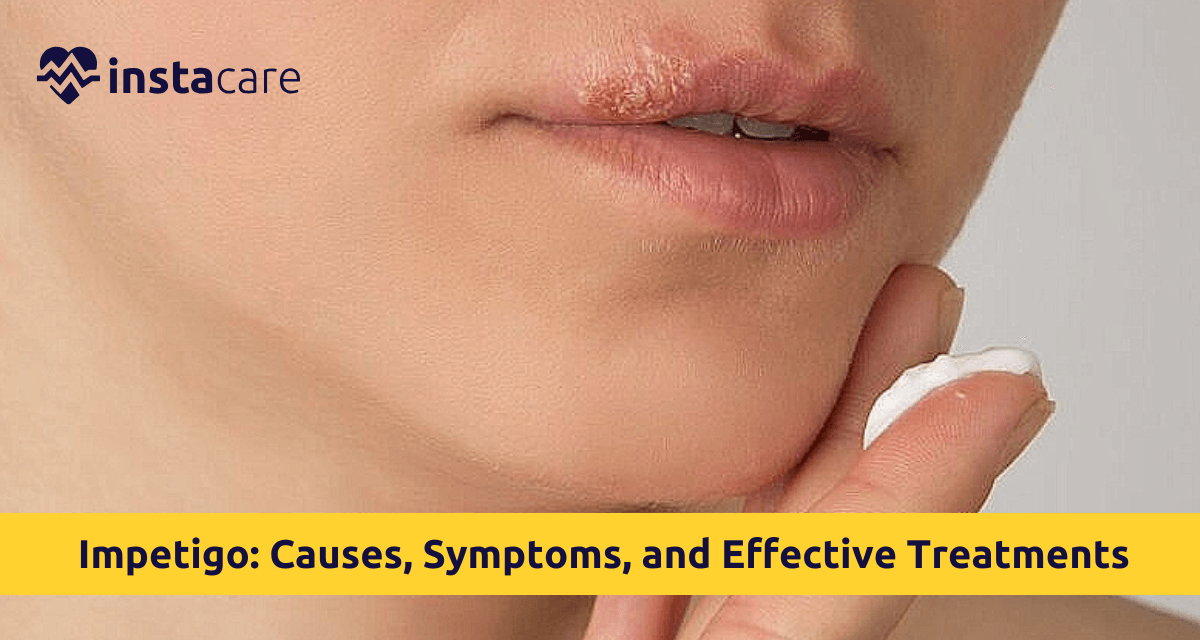Impetigo is highly contagious skin bacterial infection that predominantly occurs in children. Impetigo forms red sores, yellow crusting, and blister-like collection of fluid on the face, mouth, and arms. Mild impetigo usually occurs but may be extensive in persons like schoolchildren or daycare workers. Early-treated and diagnosed impetigo is uncomplicated infection. The following is a guide with details on what impetigo is, signs and symptoms, cause, treatment, and prevention.
What is Impetigo?
Impetigo is a Bacterial skin infection of the outer skin layer. It usually occurs due to either Staphylococcus aureus or Streptococcus pyogenes. Impetigo is contagious and occurs due to a small cut, scratch, bug bite, or other skin trauma.
This disease is most prevalent in children but can occur in adults as well who are strongly sympathetic or who play contact sports. Impetigo is a very Contagious skin infection by direct contact or through touching items of contagion like towels, toys, and clothes.
Various Types of Impetigo
There are three general forms of impetigo, each of which progresses in and severity to an uncertain extent:
- Non-bullous impetigo: Most frequent presentation, red spots which rupture and ooze honey-colored crusts, typically around the mouth and nose.
- Bullous impetigo: Bigger, more filled blisters that are longer in course and found in children younger than three years of age.
- Ecthyma: More severe and longer in course, where painful ulcers beneath thick crusts are evident. Ecthyma can lead to scarring and more serious treatment.
Some Impetigo Symptoms To Know
Impetigo signs and symptoms may differ by type and infectious severity. The most frequent symptom of impetigo is:
- Red blisters or sores, typically around the mouth and nose
- Bursting blister with a liquid
- Yellow or honey-colored thick crust after bursting the blisters
- Redness and inflammation of the skin around the infected area
- Itching skin around affected skin
- Soft redness and slight swelling around the sores
- Severe swollen lymph node and slight fever
- Impetigo in kids will get kids irritable or restless with itching or visible sores.
Main Causes of Impetigo
Impetigo happens when germs infect damaged skin. Something or disease will promote increased risk:
- Tiny skin damage: Burn, bite, scrape, or cut
- Skin disease: Eczema, dermatitis, or allergy that weakens the protective skin layer
- Direct contact: Contact with person with impetigo or shared towel, shaving, or worn clothing
- Poor hygiene: Dirty environment or not washing hands frequently
- Warm, damp environment: Favor bacterial multiplication and skin inflammation
- Crowded settings: Day care, school, sports team, or military base
The cause of the spreading of impetigo in children and in persons with weak immune systems are:
Some Fundamental Impetino Treatment Options
Treat depending upon the intensity and extent of infection. There is a possibility of most of the infection to be treated by using medicine along with good care of the skin:
- Topical antibiotics: Apply mupirocin or fusidic acid cream to heal impetigo around sores in minor impetigo.
- Oral antibiotics: Oral cephalexin or dicloxacillin antibiotics are given in the event of infection spread or recurrence in character.
- Shaving skin: Take a shower in warm water with antiseptic soap and apply medicine.
- Do not scratch: Trim nail and apply anti-itch cream so as not to disturb infection.
- Cover up the infection: Padding the wound in a non-irritating manner such that other people should not become infected.
The treatment for impetigo would take 7 to 10 days as Impetigo healing time. It can be finished even when taking antibiotics even though one is experiencing it more quickly.
How to Cure Impetigo at Home?
Along with medicines, home remedy will hasten recovery and forestall transmission:
- Bathe contaminated skin twice a day with lukewarm water and mild soap
- Dispose of and dry gauze or tissue properly
- Apply topical antibiotic ointment as directed by a physician
- Bandage open wounds with sterile bandages so that they will not be contaminated
- Do not touch and scratch contaminated tissues
- Wash hands often and disinfect most contacted surfaces
- Wash clothes, linen, and towels in hot water
Home care is required for uncomplicated impetigo and it prevents the recurrence of impetigo and secondary infection.
Impetigo vs Eczema – What's the Difference?
Although eczema and impetigo erupt on the skin and both can cause redness and swelling, they are quite distinct.
- Eczema is a genetic, uncontrollable skin disorder caused by an overactive immune system. Eczema erupts in dry, scaly, itchy patches on the hands, face, elbows, and knees. Eczema must be managed with corticosteroids and moisturizers for decades.
- Impetigo is extremely contagious bacterial infection, however. It occurs most frequently when bacteria infect an open skin, i.e., an open sore or infected inflamed skin, like eczema skin. It advances to blisters full of fluid which ooze, crusting sores, and yellow crust. Impetigo requires antibiotics but eczema secondary infection only.
Being specific is necessary because one should not treat one for the other, otherwise, it will worsen or delay healing.
Tips on How to Avoid Impetigo?
Although impetigo is curable, it's always safer to avoid, especially when there are large crowds around. The following are wonderful ways of evading it:
- Practice good hygiene: Wash frequently with soap and water
- Keep skin and cover clean: Clean bites, scrapes, and cuts at once
- No sharing of personal items: Do not share towels, clothing, or grooming equipment
- Use disinfectants: Disinfect objects like gym equipment, bathroom sink, and toys frequently
- Stay home if sick: Keep children home from school until not contagious (usually 24–48 hours after treatment begins)
- Clip fingernails short: To avoid scratching and germ spreading
All these are highly effective in avoiding infection and stopping outbreak before occurrence.
Conclusion
Impetigo is a skin infection caused by bacteria that occurs mostly in children but can be in any age group. It often presents with blisters and crusts of a red color and is extremely contagious by contact. Pain relief and complications can be prevented by early diagnosis and an understanding of how to manage it. Topical antibiotics will be enough to treat most of the small cases, but oral therapy is necessary for severe cases. With or without hygiene and prevention, it can be prevented from becoming an issue at the onset, especially with children or crowds.
With children or adults, better to know in order to recover faster and less disrupted daily activities. Above all, impetigo can be prevented and cured with proper information and treatment.
Please book an appointment with the
Best Dermatologist in Lahore, Karachi, Islamabad, and all major cities of Pakistan through
InstaCare, or call our helpline at 03171777509 to find a verified doctor for your disease.

